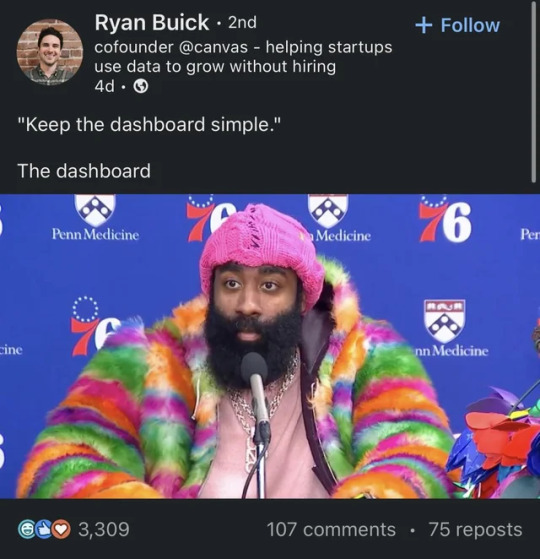#power BI dashboard
Explore tagged Tumblr posts
Text
Power BI Dashboard
You Can Start the Power BI Training Courses now in Thane. Analyzing and interpreting data using Power BI to derive actionable insights. This may involve creating visualizations, reports, and dashboards. Designing and developing reports and dashboards using Power BI. This involves transforming raw data into a format suitable for analysis. Developing and maintaining data infrastructure to support Power BI reports, ensuring data is accessible and accurate. join now to start the career with Actifyzone center. For more information contact us
For More Information
Name:- Actifyzone
Email Id:[email protected]
Address:-3rd Floor, Guruprerana ,Opp. Jagdish Book Depot, Above Choice Interiors, Naik Wadi, Near Thane Station, Thane (W) 400602
Contact no:--9867476 400
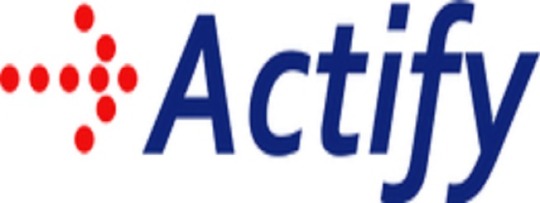
2 notes
·
View notes
Text
How Power BI Enhances Workflow Automation?

In today’s fast-paced business environment, organizations are continuously seeking tools and technologies that enhance productivity and streamline operations. Workflow automation has emerged as a game-changing strategy, and Power BI—Microsoft’s robust business analytics service—plays a pivotal role in achieving this goal. From Power BI dashboard development to integrating actionable insights, this platform empowers businesses to automate data analysis, decision-making, and reporting processes. This article delves into how Power BI transforms workflow automation, spotlighting real-world Power BI dashboard examples and insights from Power BI development experts to illustrate its immense potential.
What is Workflow Automation, and Why Does It Matter?
Workflow automation refers to the use of technology to perform routine tasks and processes with minimal human intervention. By automating workflows, businesses can:
Save Time: Reduce the time spent on manual data entry and repetitive tasks.
Improve Accuracy: Eliminate human error in critical processes.
Enhance Scalability: Handle growing data volumes efficiently.
Boost Productivity: Allow employees to focus on strategic initiatives instead of mundane tasks.
Power BI fits perfectly into this ecosystem by providing a centralized platform to analyze, visualize, and share data insights seamlessly, enhancing the automation of workflows across departments.
1. The Role of Power BI in Workflow Automation
Power BI Dashboard Development for Streamlined Insights
Power BI dashboards are the backbone of data visualization. They allow businesses to consolidate data from various sources into interactive, easy-to-understand formats. For workflow automation, these dashboards provide real-time updates, ensuring that teams have instant access to critical metrics without manual input.
Custom Dashboards: Tailored to specific organizational needs, these dashboards enable automated reporting and tracking.
Real-Time Data Monitoring: With live data streams, businesses can make proactive decisions and automate responses.
Seamless Integration: Power BI integrates with tools like Microsoft Power Automate to trigger workflows based on data-driven events.
Power BI’s Data Transformation Capabilities
Power BI’s Power Query Editor allows users to clean, transform, and prepare data for analysis. Automation features, such as scheduled refreshes and query parameters, ensure data stays up-to-date without manual intervention.
Automated Data Refresh: Keep dashboards updated with the latest information.
Data Modeling: Simplify complex data relationships for faster insights.
Templates and Reusability: Create reusable templates for recurring workflows.
2. Real-World Power BI Dashboard Examples in Automation
1. Sales Performance Monitoring
A global retail company utilized Power BI to automate their sales performance tracking. Instead of manually compiling sales data from multiple regions, a Power BI dashboard consolidated the information, enabling:
Automatic updates from CRM systems.
Real-time sales metrics displayed visually.
Triggered alerts for underperforming regions.
2. Inventory Management
Manufacturers often face challenges in maintaining optimal inventory levels. With Power BI, companies automate inventory tracking through dashboards that:
Sync with ERP systems to monitor stock levels.
Forecast demand based on historical trends.
Automatically alert teams to reorder supplies.
3. Financial Reporting
Financial teams benefit from automated Power BI dashboards that simplify reporting processes by:
Consolidating data from accounting software.
Providing real-time profit and loss insights.
Generating automated reports for stakeholders.
3. Why Businesses Rely on Power BI Experts
The complexity of building effective dashboards and integrating Power BI into existing workflows often necessitates the expertise of Power BI development experts. These professionals ensure:
Tailored Solutions: Customization to meet unique business needs.
Optimal Performance: Dashboards are optimized for speed and reliability.
Advanced Features: Implementation of AI and predictive analytics.
Hiring a Power BI company or consulting with certified experts ensures that businesses maximize their investment in workflow automation.
4. Integration with Other Microsoft Tools
Power Automate
Power BI works seamlessly with Power Automate to create event-driven workflows. For instance:
Automatically send reports to stakeholders when a dashboard metric crosses a threshold.
Trigger email notifications based on data trends.
Initiate approval processes within Microsoft Teams.
Microsoft Teams and SharePoint
With integration capabilities, Power BI dashboards can be embedded directly into Microsoft Teams or SharePoint, allowing team members to access insights without switching platforms.
5. Future Trends in Power BI and Workflow Automation
The evolution of Power BI is continuously expanding its capabilities in workflow automation. Future trends include:
AI Integration: Enhanced predictive analytics for smarter decision-making.
Natural Language Queries: Allowing users to interact with dashboards conversationally.
Increased Customization: Advanced tools for creating bespoke workflows.
Scalability: Handling larger datasets with faster processing speeds.
Conclusion
Power BI is more than just a data visualization tool; it’s a powerhouse for workflow automation. From Power BI dashboard development to the expertise of Power BI experts, businesses are leveraging this platform to transform their operations. By integrating powerful analytics with automated processes, organizations can achieve unprecedented efficiency, accuracy, and growth.
Whether you're looking to streamline financial reporting, optimize inventory management, or enhance sales tracking, Power BI offers unparalleled solutions tailored to your needs. Invest in a Power BI company or consult with Power BI development experts to unlock the full potential of workflow automation. The future of business efficiency is here, and it’s powered by Power BI.
#Power BI dashboard development#Power BI company#Power BI Experts#power BI dashboard examples#power BI development experts#power BI dashboard
0 notes
Text
create comparison dashboard in power bi
#power bi dashboard#data visualization#Power Bi#power bi service#power bi reporting#power bi consulting services#power bi services
0 notes
Text
Why You Should Hire a Power BI Developer for Your Business
In today’s data-driven world, the ability to leverage business intelligence (BI) is crucial for making informed decisions and staying competitive. Power BI, a powerful data visualization and analytics tool from Microsoft, has emerged as a leading solution for transforming raw data into actionable insights. If you want to enhance your organization’s ability to analyze and interpret data, hiring a Power BI developer is a smart move. Here's why you should consider hiring a Power BI developer and how it can benefit your business.
Unlock the Full Potential of Power BI
Power BI is more than just a data visualization tool; it’s a robust business intelligence platform that integrates with a variety of data sources, from databases to cloud services. However, to truly unlock its full potential, it’s essential to have a Power BI developer who understands the intricacies of the platform. A skilled developer will know how to design interactive dashboards, automate reporting, and ensure your BI solutions are tailored to meet your organization’s specific needs.
Custom Dashboards and Reports
Every business has unique data needs, and a one-size-fits-all approach doesn’t always work. By hiring a Power BI developer, you can get custom dashboards and reports that are aligned with your business objectives. Power BI developers are adept at creating reports that allow stakeholders to easily visualize and interpret complex data. Whether you're analyzing sales trends, operational efficiency, or customer insights, a developer can design intuitive, interactive reports that make decision-making easier.
Streamlined Data Integration
One of Power BI’s greatest strengths is its ability to integrate with a wide range of data sources, including Excel, SQL Server, Google Analytics, and even cloud platforms like Azure. A Power BI developer is an expert in connecting and blending data from various sources, ensuring you have access to comprehensive, up-to-date information in one unified platform. This streamlined data integration process helps eliminate silos and enables better decision-making across your organization.
Enhanced Data Security
With the growing threat of data breaches, it’s essential to ensure your business intelligence systems are secure. When you hire a Power BI developer, they can set up proper data security measures within Power BI, ensuring that sensitive information is protected. Developers can implement row-level security, encryption, and access control features that restrict data access based on user roles, ensuring that only authorized users can view specific data sets.
Improved Business Decision-Making
The ultimate goal of Power BI is to provide actionable insights that lead to smarter business decisions. By hiring a Power BI developer, you ensure that your business intelligence solutions are designed with this goal in mind. Developers can build custom metrics, automated alerts, and forecasting models that enable you to make data-driven decisions faster. With real-time data insights, your business can stay ahead of the competition and respond quickly to market changes.
Scalability and Flexibility
As your business grows, so do your data needs. Power BI is a scalable solution, and a Power BI developer ensures your BI infrastructure grows alongside your business. Whether you need to add more data sources, users, or features, a skilled developer can help implement changes smoothly, ensuring your BI solution continues to support your organization’s evolving requirements.
Hire a Power BI Developer from Techcronus
If you’re looking to leverage the full power of Power BI for your business, hiring a dedicated Power BI developer is the key. At Techcronus, we offer expert Power BI development services tailored to your business needs. Our developers can help you design custom dashboards, integrate data sources, ensure data security, and ultimately enhance your decision-making processes. Whether you need a Power BI consultant or a full-time developer, we have the expertise to help your business harness the power of data.
Contact us today to learn more about how our Power BI development services can transform your business insights and improve your operations.
#Power BI developer#power bi consulting firms#microsoft power bi development#microsoft power bi developer#power bi development services#power bi service#power bi consulting services#power bi dashboard
0 notes
Text
Building Interactive Financial Dashboards with Power BI
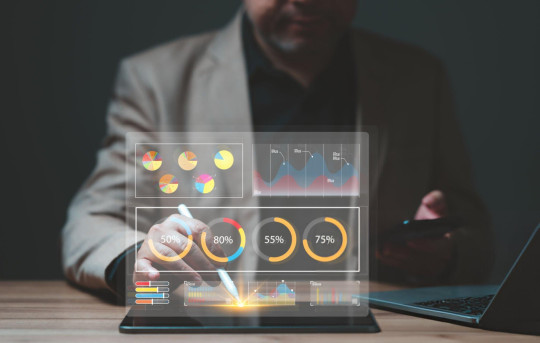
Introduction to Power BI for Financial Dashboards
Power BI stands out as a top-tier data visualization tool, offering users a platform to build comprehensive dashboards that deliver valuable insights. Unlike static spreadsheets, Power BI dashboard are interactive and allow real-time data manipulation, making them ideal for financial analysis. Financial dashboards designed with Power BI can transform raw data into visual representations that highlight performance trends, key metrics, and forecasts, essential for business decision-making.
For companies that rely heavily on financial data—such as accounting firms, investment organizations, or finance departments within larger companies—having access to an up-to-date and interactive financial dashboard can streamline reporting processes and improve decision-making capabilities.
1. Why Choose Power BI for Financial Dashboards?
Power BI’s flexibility and advanced visualization features make it ideal for creating financial dashboards that meet specific needs, from monitoring revenue growth and profit margins to tracking budgets, forecasts, and other financial KPIs.
Key Benefits of Using Power BI for Financial Dashboards
Real-Time Data Access: Power BI dashboards support real-time updates, allowing users to make immediate adjustments and informed decisions.
Data Integration: Power BI seamlessly integrates with multiple data sources, including Excel, SQL databases, and cloud-based services, which is crucial for comprehensive financial analysis.
Customizability and Interactivity: With Power BI, financial dashboards can be tailored with custom visuals and features to meet unique business requirements.
Advanced Analytical Capabilities: Users can leverage DAX (Data Analysis Expressions) for sophisticated calculations, creating dashboards that provide deep insights beyond basic visualizations.
Accessibility and Collaboration: Dashboards can be shared with stakeholders, making it easy for teams to collaborate and access data from anywhere.
2. Key Steps in Power BI Dashboard Development
Building an interactive financial dashboard with Power BI involves a series of structured steps, from defining the objectives to publishing and sharing the final dashboard.
Step 1: Define the Objective and Scope of the Dashboard
The development process begins by understanding what insights the business seeks from the dashboard. For a financial dashboard, objectives might include monitoring profitability, tracking expenses, or analyzing cash flow trends. Clear objectives streamline the design process and ensure the final product aligns with business needs.
Step 2: Identify and Connect to Data Sources
Data integration is a significant aspect of Power BI. Power BI’s flexibility allows it to connect to a wide range of financial data sources, including:
Excel for historical data and budgets
ERP systems like SAP or Oracle for real-time financial transactions
CRM platforms for revenue data
SQL databases for complex datasets
Once connected, data can be organized and transformed using Power BI’s data transformation tools, ensuring consistency and accuracy across the dashboard.
Step 3: Data Modeling and Transformation
Data modeling is crucial in financial dashboards, where data from multiple sources often needs to be structured for accurate analysis. Power BI’s Power Query Editor enables users to clean, transform, and model data, providing a solid foundation for reporting.
Key components of data modeling in Power BI include:
Creating relationships between tables for comprehensive reporting
DAX formulas for custom calculations, such as calculating profit margins, cash flow, and ROI
Hierarchy setups for drill-down capabilities (e.g., yearly, quarterly, and monthly views)
Step 4: Select the Right Visuals for Financial Metrics
The right visuals bring clarity to financial data, making it easier for users to interpret complex metrics. Commonly used Power BI visuals in financial dashboards include:
Line charts for revenue and expense trends over time
Column and bar charts for budget vs. actual comparisons
Pie charts for portfolio distribution or expense allocation
Cards for key metrics like profit, revenue, and net income
Gauge visuals to track KPIs like cash reserves or profitability ratios
Choosing the right visual is essential to presenting data effectively. For example, a line chart might be better suited for showing trends over time, while a bar chart can highlight comparative metrics.
Step 5: Add Interactivity and Filters
Power BI’s interactivity is one of its standout features. Adding filters and slicers enables users to explore data by specific dimensions, such as:
Time periods (quarterly, monthly, yearly)
Departments or business units
Regions or locations
By allowing users to filter data, dashboards become powerful tools for in-depth analysis, letting users identify trends, spot anomalies, and make informed decisions.
Step 6: Formatting and Aesthetics
Aesthetics play an essential role in how information is consumed. Power BI provides ample options for customizing themes, fonts, and colors to make dashboards visually appealing. Consistent formatting and color-coding help in distinguishing various financial metrics, which is crucial when dealing with extensive datasets.
Step 7: Publish and Share the Dashboard
Once the dashboard is complete, it’s time to publish it on the Power BI Service or embed it in applications or web portals. Power BI’s sharing capabilities make it easy to distribute dashboards across the organization, ensuring stakeholders have access to valuable insights in real time.
3. Best Practices for Effective Financial Dashboards
To create a dashboard that not only looks good but also serves its purpose, consider these best practices:
Keep It Simple: Avoid overcrowding the dashboard with too many visuals. Focus on key metrics and KPIs that matter.
Use Data Hierarchies: Organize data so users can drill down for more detailed views, such as quarterly or monthly performance.
Optimize for Performance: Simplify complex data models and avoid loading excessive amounts of data to improve performance.
Ensure Consistency: Use a uniform color palette, font, and style across all visuals for a cohesive look.
Prioritize Key Metrics: Highlight important metrics like revenue, expenses, and net profit, placing them in prominent positions.
4. Advanced Customizations for Financial Dashboards
For businesses seeking to go beyond basic visualizations, Power BI offers advanced customization options:
Advanced DAX for Financial Calculations
With DAX, users can create custom calculations that enable deeper financial analysis. Examples include:
Year-over-Year Growth Calculations
Profit Margins and Ratios
Rolling Averages for Smoother Trends
Dynamic Time Intelligence for comparing data across custom periods
Custom Visuals for Enhanced Insights
Power BI’s AppSource offers numerous custom visuals that provide additional flexibility for financial analysis, such as:
Financial KPI visualizations for tracking critical financial metrics
Heat maps for highlighting profitable regions or departments
Decomposition Trees for drilling down into contributing factors of revenue or expenses
5. Real-World Power BI Dashboard Examples
Revenue and Profitability Dashboard
This type of dashboard could include key metrics like total revenue, gross profit margin, and net profit. Visuals may include line graphs for revenue trends, bar charts for expense breakdowns, and cards for displaying key figures.
Budget vs. Actuals Dashboard
Designed to compare actual expenses and revenue to budgeted amounts, this dashboard is essential for financial forecasting and analysis. With clear visuals and conditional formatting, users can easily spot deviations from budgeted amounts.
Cash Flow Analysis Dashboard
Cash flow is a crucial aspect of financial health. A cash flow analysis dashboard could include visuals such as area charts and line graphs, highlighting cash inflows and outflows over time, and allowing drill-down capabilities for in-depth analysis.
6. Leveraging Power BI Experts for Dashboard Development
For companies without in-house Power BI expertise, partnering with Power BI development experts can be invaluable. Skilled Power BI experts can streamline the entire process, from setting up the data sources to creating visually compelling and data-driven dashboards that meet business needs. Additionally, Power BI experts ensure dashboards are optimized for performance and scalability.
Power BI consulting companies or freelance Power BI experts can offer customized solutions that suit your specific requirements, ensuring a seamless dashboard development process.
7. Conclusion
Building interactive financial dashboards with Power BI can transform how businesses view and utilize their data. From tracking profit margins and analyzing expenses to comparing budgets and forecasting trends, financial dashboards make it easy for stakeholders to gain a comprehensive view of their finances in real-time. By following best practices and leveraging Power BI’s full capabilities, businesses can create dashboards that not only display data but also provide actionable insights that drive growth and strategic decisions.
Whether you’re new to Power BI or looking to optimize an existing dashboard, these steps and tips will guide you in creating effective financial dashboards that meet your business’s unique needs. With Power BI’s ability to bring data to life through interactive visuals and advanced analytics, it remains a top choice for financial reporting and data visualization.
#Power BI dashboard development#Power BI company#Power BI Experts#power BI dashboard examples#power BI development experts#power BI dashboard
0 notes
Text
Optimizing Power BI Dashboards for Real-Time Data Insights
Today, having access to real-time data is crucial for organizations to stay ahead of the competition. Power BI, a powerful business intelligence tool, allows businesses to create dynamic, real-time dashboards that provide immediate insights for informed decision-making. But how can you ensure your Power BI dashboards are optimized for real-time data insights? Let’s explore some key strategies.

1. Enable Real-Time Data Feeds
You'll need to integrate live data sources to get started with real-time data in Power BI. Power BI supports streaming datasets, which allow data to be pushed into the dashboard in real time. Ensure your data sources are properly configured for live streaming, such as APIs, IoT devices, or real-time databases. Power BI provides three types of real-time datasets:
Push datasets
Streaming datasets
PubNub datasets
Each serves different use cases, so selecting the appropriate one is key to a smooth real-time experience.
2. Utilize DirectQuery for Up-to-Date Data
When real-time reporting is critical, leveraging DirectQuery mode in Power BI can be a game-changer. DirectQuery allows Power BI to pull data directly from your database without needing to import it. This ensures that the data displayed in your dashboard is always up-to-date. However, ensure your data source can handle the performance load that comes with querying large datasets directly.
3. Set Up Data Alerts for Timely Notifications
Data alerts in Power BI enable you to monitor important metrics automatically. When certain thresholds are met or exceeded, Power BI can trigger alerts, notifying stakeholders in real time. These alerts can be set up on tiles pinned from reports with gauge, KPI, and card visuals. By configuring alerts, you ensure immediate attention is given to critical changes in your data, enabling faster response times.
4. Optimize Dashboard Performance
To make real-time insights more actionable, ensure your dashboards are optimized for performance. Consider the following best practices:
Limit visual complexity: Use fewer visuals to reduce rendering time.
Use aggregation: Rather than showing detailed data, use summarized views for quicker insights.
Leverage custom visuals: If native visuals are slow, explore Power BI’s marketplace for optimized custom visuals.
5. Utilize Power BI Dataflows for Data Preparation
Data preparation can sometimes be the bottleneck in providing real-time insights. Power BI Dataflows help streamline the ETL (Extract, Transform, Load) process by automating data transformations and ensuring that only clean, structured data is used in dashboards. This reduces the time it takes for data to be available in the dashboard, speeding up the entire pipeline.
6. Enable Row-Level Security (RLS) for Personalized Real-Time Insights
Real-time data can vary across different users in an organization. With Row-Level Security (RLS), you can control access to the data so that users only see information relevant to them. For example, sales teams can receive live updates on their specific region without seeing data from other territories, making real-time insights more personalized and relevant.
7. Monitor Data Latency
While real-time dashboards sound ideal, you should also monitor for data latency. Even with live datasets, there can be delays depending on your data source’s performance or how data is being processed. Ensure your data pipeline is optimized to reduce latency as much as possible. Implement caching mechanisms and optimize data refresh rates to keep latency low and insights truly real-time.
8. Embed Real-Time Dashboards into Apps
Embedding Power BI dashboards into your business applications can significantly enhance how your teams use real-time data. Whether it’s a customer support tool, sales management app, or project management system, embedding Power BI visuals ensures that decision-makers have the most recent data at their fingertips without leaving their workflow.
9. Regularly Update Data Sources and Models
Data sources evolve over time. Regularly update your data models, refresh connections, and ensure that the data you’re pulling in is still relevant. As your business needs change, it’s essential to refine and adjust your real-time data streams and visuals to reflect these shifts.
Conclusion
Optimizing Power BI dashboards for real-time data insights requires a combination of leveraging the right data connections, optimizing performance, and ensuring the dashboards are designed for quick interpretation. With the ability to access real-time data, businesses can improve their agility, make faster decisions, and stay ahead in an increasingly data-driven world.
By following these strategies, you can ensure that your Power BI dashboards are fully optimized to deliver the timely insights your organization needs to succeed.
0 notes
Text
youtube
Unlock the power of Business Intelligence (BI) and elevate your business to new heights! In this video, we break down the fundamentals of BI, showing you how data-driven decisions can transform your company. Learn about the core components of BI, including Data Collection, Integration, Analysis, and Visualization, and discover why BI is essential for making informed decisions. Key Takeaways: Understand the basics of Business Intelligence Learn the key steps involved in BI Discover the benefits of BI for your business See real-world examples of BI in action Whether you're new to BI or looking to deepen your understanding, this video is for you. Don't forget to like, comment, and subscribe for more insights on how to leverage BI for your business growth! Helpful Resources: Explore our blog for more in-depth articles: https://vuelitics.com/blog
Connect With Us:
Facebook: https://www.facebook.com/profile.php?id=61560856345182&sk=about_details Instagram:https://www.instagram.com/vuelitics_velan/ Twitter:https://x.com/vuelitics Linkedin: https://www.linkedin.com/company/vuelitics/ Youtube: https://www.youtube.com/@Vuelitics Website: https://vuelitics.com/
#Business Intelligence#Data Analytics#BI#Informed Decisions#Business Growth#Data Driven#Business Insights#Data Strategy#BI Tools#Data Integration#what is business intelligence#what is bi?#power bi dashboard#business intelligence introduction#business intelligence and analytics#what is business intelligence and analytics#what is business intelligence tools#what is business intelligence explain in brief#what is business intelligence (bi)#BI Systems#Youtube
0 notes
Text
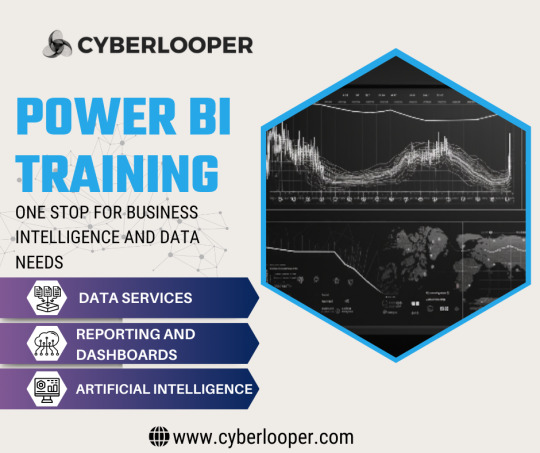
Cyber Looper offers comprehensive Power BI training in the United States, empowering individuals and businesses with essential skills for effective data analysis and visualization. Our expert-led courses cover Power BI fundamentals, advanced techniques, and real-world applications, ensuring participants gain a competitive edge in harnessing the full potential of this powerful business intelligence tool.
1 note
·
View note
Text
Exploring the benefits of Power BI software: Everything you need to know
Power BI is a business analytics service by Microsoft. It provides interactive visualizations and business intelligence capabilities with an interface simple enough for end users to create their own reports and dashboards.
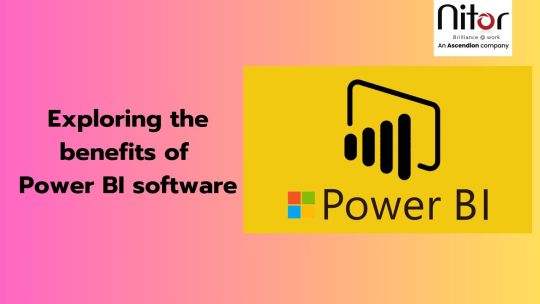
Here are some key benefits of using Power BI:
Data Visualization: It allows users to create compelling, interactive, and visually appealing reports and dashboards. It supports a variety of data visualizations, including charts, graphs, maps, and tables, making it easier to interpret and analyze data.
Ease of Use: It has a user-friendly interface that allows both technical and non-technical users to create reports and dashboards. The drag-and-drop functionality simplifies the process of building visualizations, making it accessible to a broader audience.
Data Connectivity: It can connect to a wide range of data sources, including Excel spreadsheets, cloud-based and on-premises data sources, databases, and online services. This flexibility allows users to consolidate and analyze data from various sources in one central location.
Real-Time Analytics: It can be configured to work with real-time data streams, enabling users to monitor and analyze data as it is generated. This is particularly useful for businesses that require up-to-the-minute insights to make informed decisions.
Integration with Microsoft Products: It integrates seamlessly with other Microsoft products and services, such as Excel, Azure, and SQL Server. This integration enhances collaboration and streamlines workflows for organizations already using Microsoft's ecosystem.
Mobile Access: It offers mobile apps for iOS and Android devices, allowing users to access reports and dashboards on the go. This ensures that decision-makers have access to critical business insights regardless of their location.
Natural Language Processing (Q&A): Power BI incorporates natural language processing capabilities, enabling users to ask questions about their data in plain language. The system then generates visualizations based on the query, making data exploration more intuitive.
Security and Governance: It provides robust security features, allowing administrators to control access to reports and dashboards. It also supports row-level security, ensuring that users only see the data relevant to their roles.
Scalability: It can scale to meet the needs of both small businesses and large enterprises. It can handle large volumes of data and accommodate increased user loads as organizations grow.
Cost-Effective: It offers various pricing plans, including a free version with limited features. This makes it accessible to small businesses and individuals while providing the option to scale up as needed.
Get acquainted with Power BI in our blog.
#company development software#development company software#software company#power bi#power bi services#power bi dashboard#power bi tool#microsoft bi#software businesses#nitorinfotech
0 notes
Text
Learn Power BI Tutorial Beginner to Pro 2023 Edition [Full Course]
Introduction to Power BI Course
Welcome to the Power BI Course! In this comprehensive training program, we will embark on an exciting journey to explore the powerful world of Microsoft Power BI, a leading business intelligence and data visualization tool. This course is designed to equip you with the essential skills and knowledge required to harness the full potential of Power BI and make data-driven decisions with confidence.
1. The Power of Data Visualization: In today's data-driven world, organizations generate massive amounts of data. However, raw data alone is not enough to drive informed decision-making. The ability to transform data into meaningful insights is crucial, and this is where Power BI shines. By providing an intuitive and user-friendly interface, Power BI enables you to create captivating visualizations, interactive dashboards, and insightful reports, empowering you to extract valuable information from your data effortlessly.
2. Understanding Power BI: Before diving into the technical aspects, we will start by understanding the fundamental concepts of Power BI. You will learn about the components that make up the Power BI ecosystem, including Power BI Desktop, Power BI Service, and Power BI Mobile, and how they work together to deliver a seamless user experience. Additionally, we will explore the key features and functionalities that set Power BI apart as a leading BI tool.
3. Data Preparation and Transformation: One of the initial steps in any data analysis process is data preparation. In this course, we will guide you through the process of connecting Power BI to various data sources, including Excel, databases, and online services. You will learn how to transform and cleanse raw data into a structured and usable format, ensuring that your analyses are accurate and reliable.
4. Building Interactive Reports: With a solid foundation in data preparation, we will move on to designing interactive reports. Power BI offers a wide range of visualization options, from basic charts and graphs to custom visualizations created by the vibrant Power BI community. You will discover how to present data in a compelling and informative manner, using different types of visualizations to effectively communicate insights to stakeholders.
5. Creating Dynamic Dashboards: Dashboards are a crucial element of data analysis, as they provide a consolidated view of essential metrics and KPIs. In this section, we will show you how to combine multiple visualizations into interactive and dynamic dashboards. You will also learn how to set up filters, slicers, and other interactive elements to allow users to explore the data on their terms.
6. Sharing and Collaborating: Data analysis becomes more impactful when shared with others. Power BI enables you to publish and share your reports and dashboards securely, both within your organization and externally. We will walk you through the process of sharing your work and collaborating with colleagues to foster data-driven decision-making across the organization.
7. Power BI for Data Modeling and Analysis: To take your skills to the next level, we will delve into the realm of data modeling and analysis. You will learn about data relationships, calculated columns, and measures, which are essential for creating robust and accurate data models. These models will empower you to perform in-depth analyses, conduct what-if scenarios, and gain deeper insights into your data.
8. Advanced Power BI Features: As we approach the conclusion of the course, we will introduce you to some of the advanced features and functionalities that Power BI offers. This includes data security, DAX expressions, custom visuals, and incorporating AI and machine learning capabilities to enrich your reports.
Conclusion: By the end of this Power BI course, you will have gained a comprehensive understanding of the tool's capabilities and the skills to transform raw data into powerful insights. Whether you are a business professional, data analyst, or IT expert, the knowledge acquired in this course will empower you to make data-driven decisions and contribute significantly to your organization's success. So, let's get started on this exciting journey of unleashing the power of data with Power BI!
Learn Power BI Tutorial Beginner to Pro 2023 Edition [Full Course]
#power bi#power bi tutorial#power bi desktop#power bi dashboard#microsoft power bi#learn power bi#power bi training#power bi for beginners#power bi tutorial for beginners#what is power bi#power bi reports#power bi course#power bi demo#how to use power bi#power bi full course#power query#introduction to power bi#power bi project#dax power bi#power bi desktop tutorial#curso de power bi#power bi beginner#power bi pro#power bi dax#power bi data
1 note
·
View note
Text
7 Essential Tips for Our Most Effective Power Bi Dashboard

Power Bi Dashboard serve as powerful tools for data visualization and decision-making in various industries. An effective dashboard not only presents information in a clear and concise manner but also offers an intuitive and visually appealing user interface (UI) design. In this article, we will explore seven essential tips for creating compelling Dashboard UI Design that enhance user experience and enable users to derive valuable insights effortlessly.
Prioritize Data Relevance and Hierarchy
The first step in designing a successful dashboard UI is to prioritize data relevance and hierarchy. Identify the key metrics and information that are crucial for your users and place them prominently. Organize the dashboard in a hierarchical manner, emphasizing the most important data at the top or center. Use visual cues such as size, color, and positioning to guide users' attention to the most critical information. By focusing on data relevance and hierarchy, you can ensure that users quickly grasp the key insights without being overwhelmed by unnecessary details.

Read More : Power Bi Dashboard
Like Us




#Reports Power BI#Power BI#Power BI Template#Power BI Admin Template#Power Bi UI framework#Power Bi Dashboard#Dashboard UI Design
0 notes
Text
10 Tips for DAX performance inside Power BI
Are you struggling to optimize your Power BI performance when using DAX formulas? Look no further! In this article, we’ll provide you with 10 expert tips on how to enhance your Power BI experience and make the most out of its Data Analysis Expressions (DAX) language. From loading your data into Power BI to creating customized reports, these tips will help you streamline your workflow and boost…
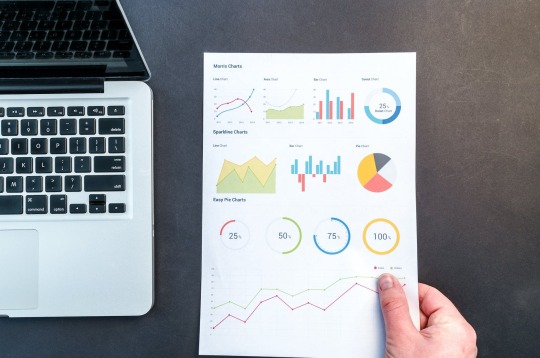
View On WordPress
0 notes
Text
0 notes
Text
design interactive power bi dashboards for your business
0 notes
Link
With Power BI, you can quickly & easily visualize your data & build interactive dashboards to help you gain deeper insights. Start today & see the power of Power BI!
0 notes
